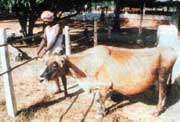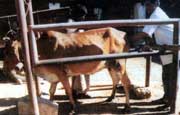Care of pregnant cattle | ||||||||||||||||||||||||||||
Care of cow at calving
Manageental measures of pregnant cattle
Metoestrus Bleeding (post Oestrus Bleeding)
Treatment
Both Cervix and uterus have enlarged
Treatment
Animal showing frequent Oestrum(Cysiic Ovaries)
.The Cyst or cysts may be 3 types
2. Luteal cyst may be one or few 3. Lutenized cyst or cystic corpus luteum
2. Due to absence of C.L
Retention of placenta in cattle and buffaloes
2. injecting 20 mg of Sodium selenite in 10 ml of groundnut oil along with 500 mg of Vitamin E (Tocopherols) intramuscularly 20 days prior to the day of calving 3. Shifting animals 5 to 10 days to disinfected or non infected shall or to grazing fields (the stalls should not contain saw dust or paddy husk as bedding but paddy straw of jungle grass or un chaffed waste fodder can be used as bedding) 4. Giving daily about 2km of walking as exercise or allow the animal to move freely in an open space for about an hour. 5. Feeding mineral mixture containing Iodine, sodium selenite and in addition feed vitamin ‘A’ (green grass) and vitamin ‘E’ (germinated grams) 6. Injecting 100 ml of 20% glucose intravenously daily for 3 days along with calcium as injection, soon after calving. 7. Injecting 3 to 4 mg of ergonobine / intramuscularly soon after calving. Curative Treatment Contraindications of manual removal of placenta
When placenta can be removed manually
Advise to owners
Abortion in cattle and buffaloes
Bacterial diseases
Viral diseases
Fungal diseases
Protzooal
Hormonal
Nutritional
Physical
Other causes
Prevention of abortions
Prolapse of vagina,Cervix & Eversion of Uterus in Bovines
Causes
Symptoms
The owner should do the following in case of prepartum prolapsed
Line of Treatment
Pregnancy diagnosis in farm animals Cattle and Buffaloes Physical & Behavioural changes
Rectal examination
Procedure
|
||||||||||||||||||||||||||||





